Cartier’s Ballon Bleu Tourbillon: Bigger Is Not Always Better
The Ballon Bleu Flying Tourbillon shown here is not Cartier’s first tourbillon.
The very first one was the Diabolo tourbillon that dates from the end of the 1980s. That was a round 36 mm watch with large lugs equipped with an automatic movement.
Roughly 20 years ago, Cartier had a few stunning Pasha tourbillons in its Collection Privée line (1998-2008). At that time the “Maison” relied on calibers like the 493 MC, based on a Girard-Perregaux movement, to power these watches. And there is absolutely nothing wrong with that since they are reliable, well-finished tourbillon movements.
But from the late 1990s, Cartier decided to develop and produce most of its own calibers, and the 9452 MC flying tourbillon caliber in the Ballon Bleu Tourbillon was one of the first examples together with the automatic 1904 MC base caliber that was built to power several mainstream models.
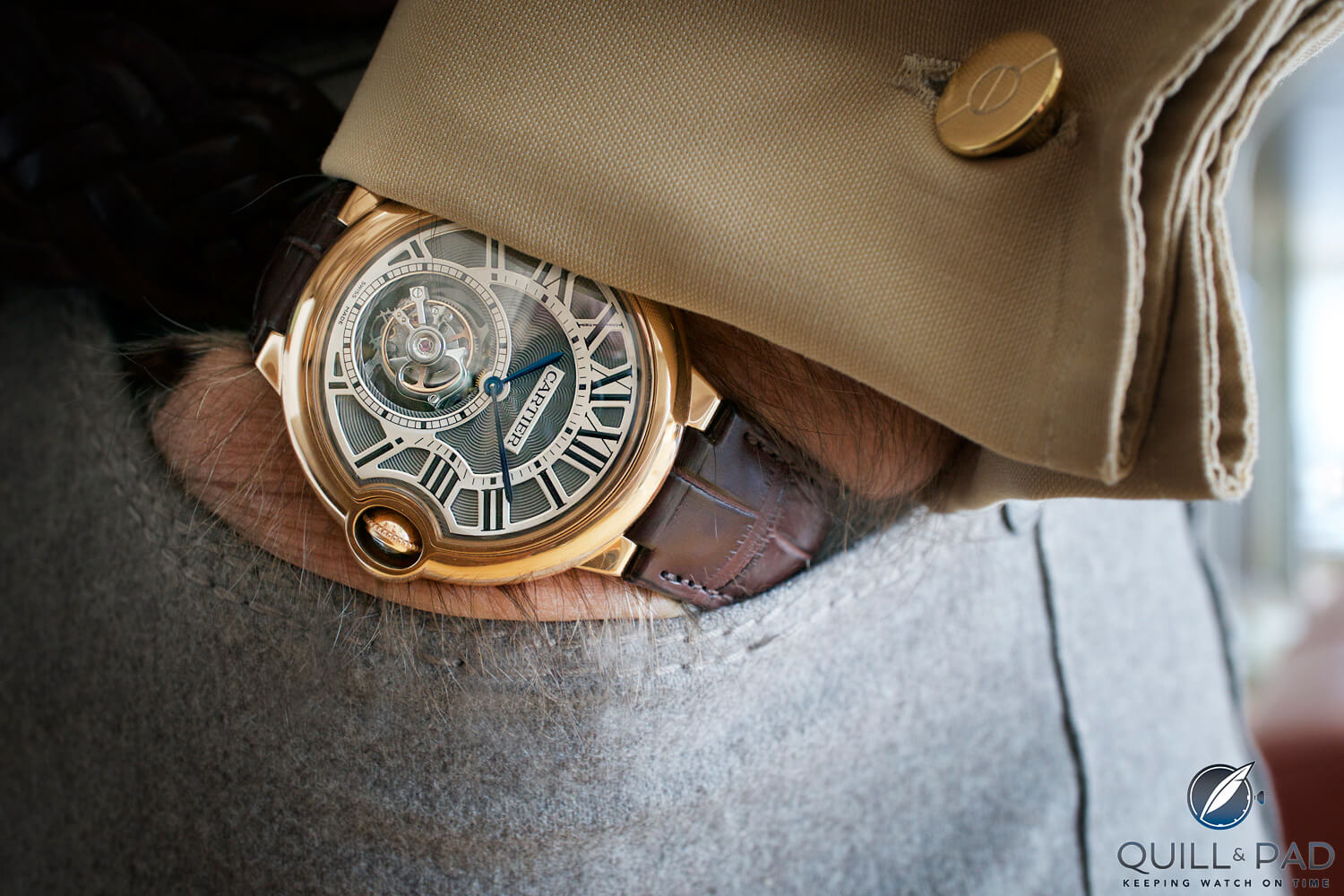
Cartier Ballon Bleu Tourbillon on the wrist (photo courtesy George Gramer)
The timepiece we discuss here is the French icon’s first tourbillon watch powered by a manufacture caliber right from its own Geneva workshop in 2008.
A smallish movement during the big watch craze
It was 2008 when the just-developed 9452 MC caliber, housed in a large 47 mm Ballon Bleu case, was briefly introduced to the press. The impressive official presentation took place at the 2009 SIHH in Geneva.
The trend and demand for large watches was strong at that time, and unfortunately Cartier followed the hype and presented its stunning new, yet fairly small, tourbillon caliber in a 47 mm Ballon Bleu case, in a 47 mm Calibre de Cartier case, in an extra-large Tank Americain, and an in an extra-large Santos 100 case.
All of them looked absolutely smashing, but all of them needed quite a large wrist to fit well and look proportioned. The oversized fashion trend for watches was fun for affordable timepieces, but when it involves an investment like that, which is what is needed to obtain a tourbillon from a high-end brand, not everyone was eager to get one and because of it not everyone took the new collection of manufacture Cartier tourbillons very seriously.
They were, after all, Cartier tourbillons. And although esteemed, Cartier had never been a manufacture to that point.
Housing this wonderful movement is such large cases was, in my opinion, a big mistake since the 9452 MC caliber was not only a huge step forward for Cartier, it was also a beautiful tourbillon caliber to look at with its characteristic white gold C indicating the seconds.
Now, ten years later, times have changed, CEOs have been replaced, and the collection has been modified.
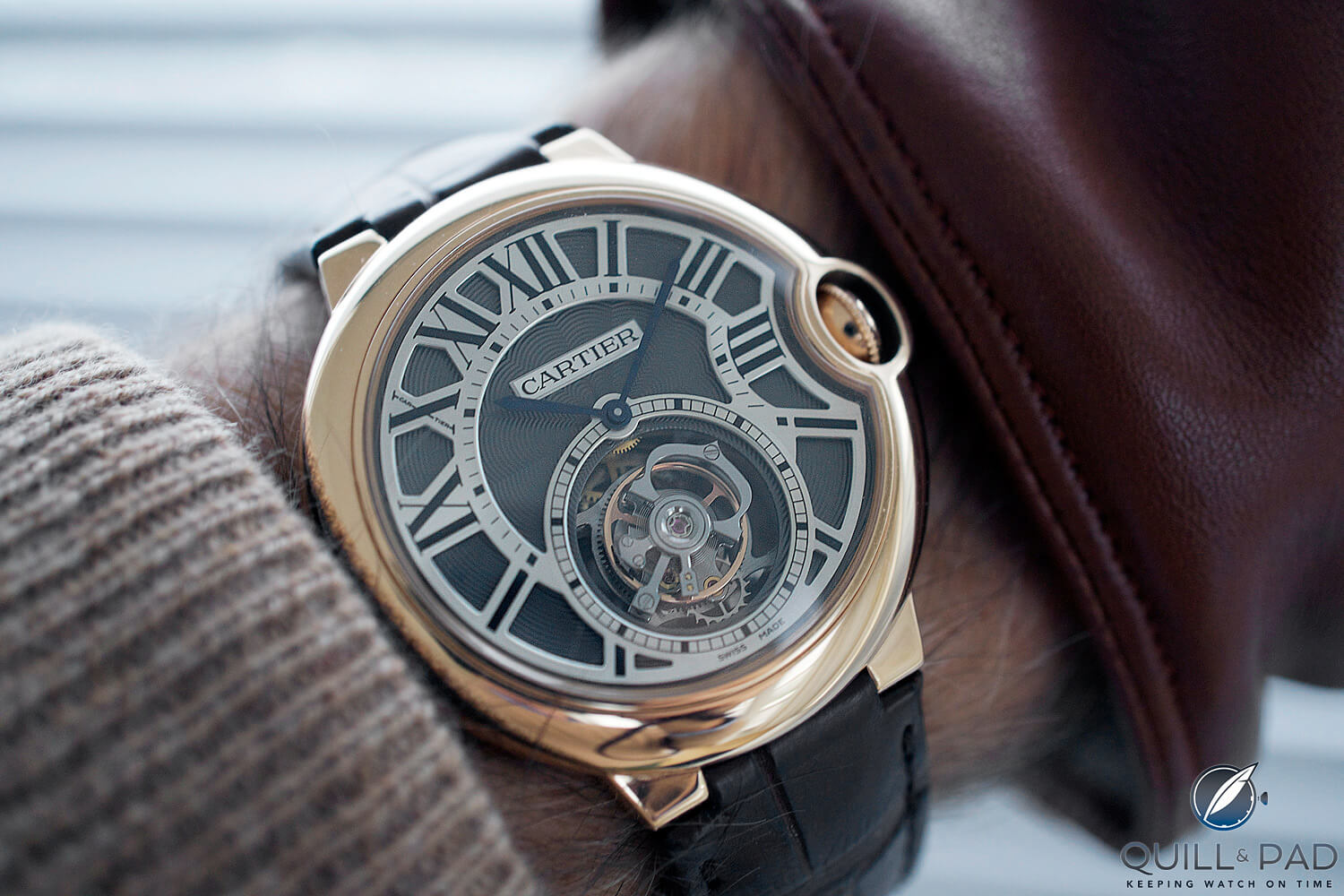
Cartier Ballon Bleu Tourbillon on the wrist (photo courtesy George Gramer)
These extra-large models from 2008, which did not really do justice to the elegant collection of Cartier watches of previous years, have now all been retired. But what has remained is that smart-looking 9452 MC flying tourbillon caliber, now much better off in more appropriately fitting cases.
When I look at Cartier’s current men’s collection, I note that the 9452 MC caliber can now be found in the dressy 40 mm Rotonde case, the masculine 40 mm Drive de Cartier, and in a 39 mm Ballon Bleu case.
And wasn’t that last one the model it all started with?
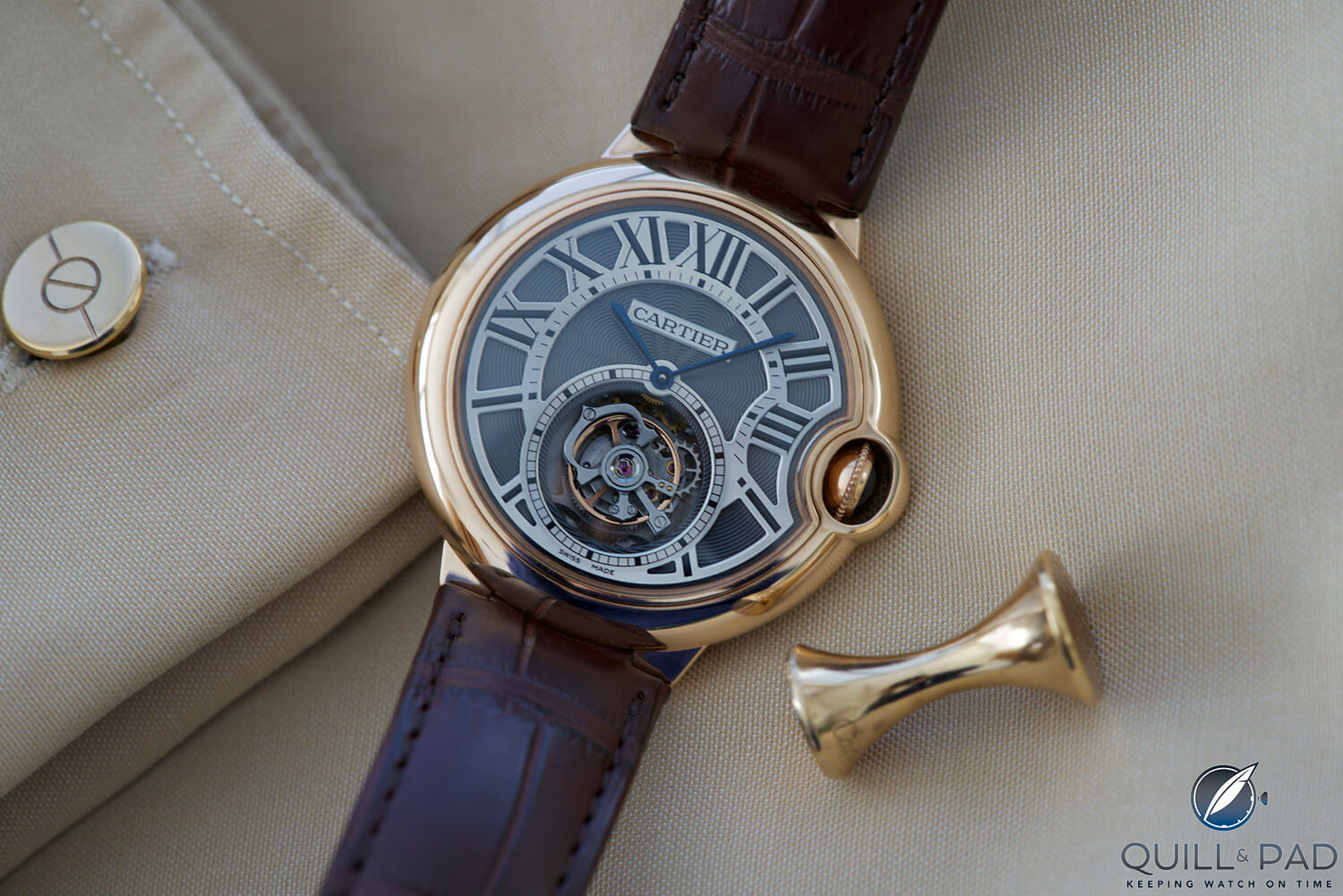
Cartier Ballon Bleu Tourbillon (photo courtesy George Gramer)
Cartier Ballon Bleu Tourbillon
The Ballon Bleu, introduced in 2007, has grown to become one of Cartier’s all-time bestselling watches and is offered in a variety of sizes from very small ladies’ models to the larger 44 mm Ballon Bleu Chronographe.
I’d never quite realized before how nicely crafted and how smartly this case is constructed. The base plate of this tourbillon model fits almost invisibly in the case, while the sapphire crystal case back provides a great view of the tourbillon caliber.
Also, the width of the case back bezel surrounding the sapphire crystal is nicely proportioned, offering ample space for the necessary engravings.
The domed sapphire crystal on the front and the soft round bezel surrounding it lends the watch a saucer shape, almost reminding me of a UFO with its smooth curves, which even includes the model’s signature crown protector.
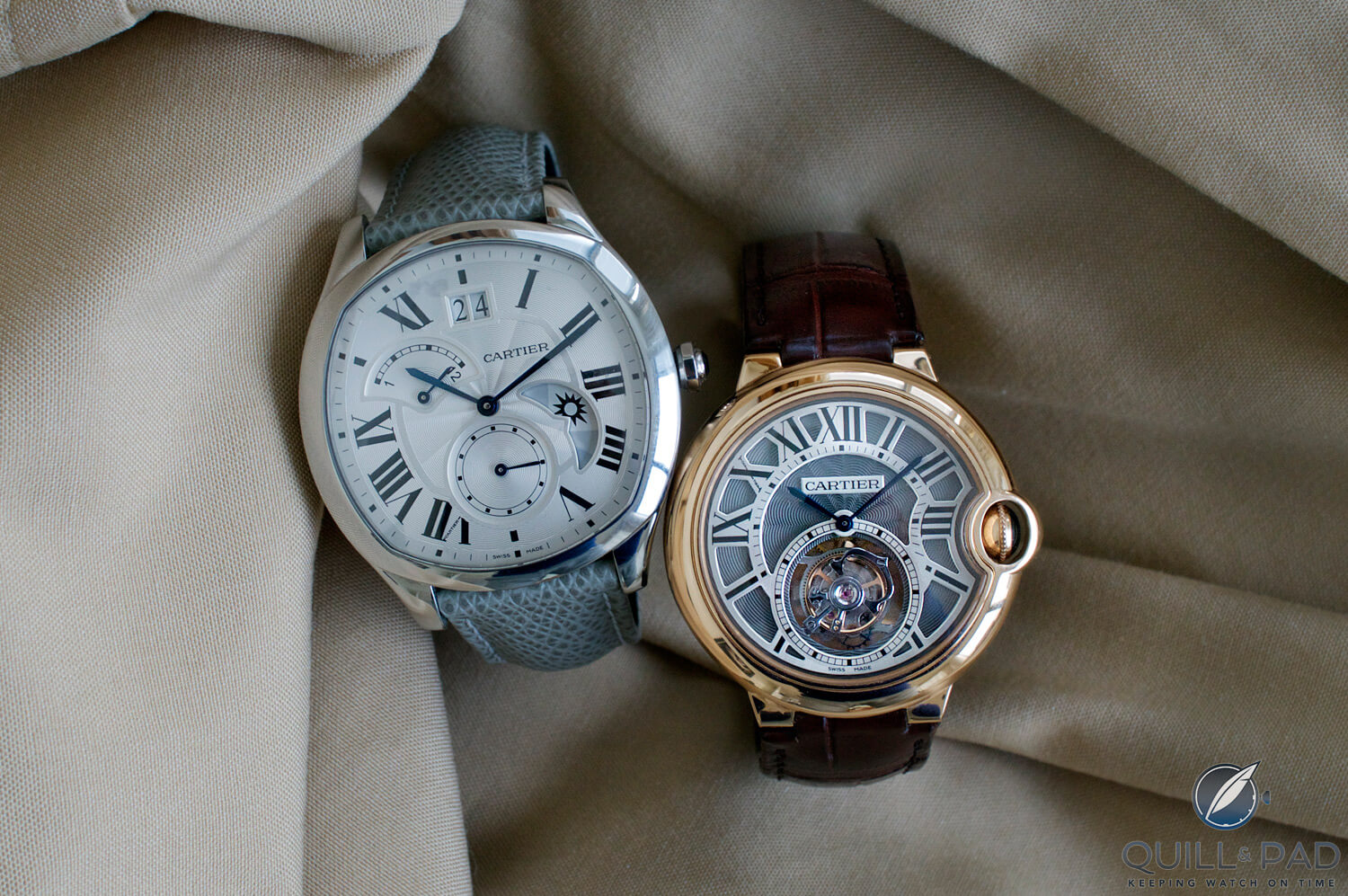
Cartier Drive (left) and Ballon Bleu Tourbillon (photo courtesy George Gramer)
The result is a watch that, especially in pink gold, can be as easily worn with a suit as with a more casual outfit. And this smaller 39 mm case is a more serious and excellent size for most men to wear, especially in comparison to the 46 mm of 2007’s debut model.
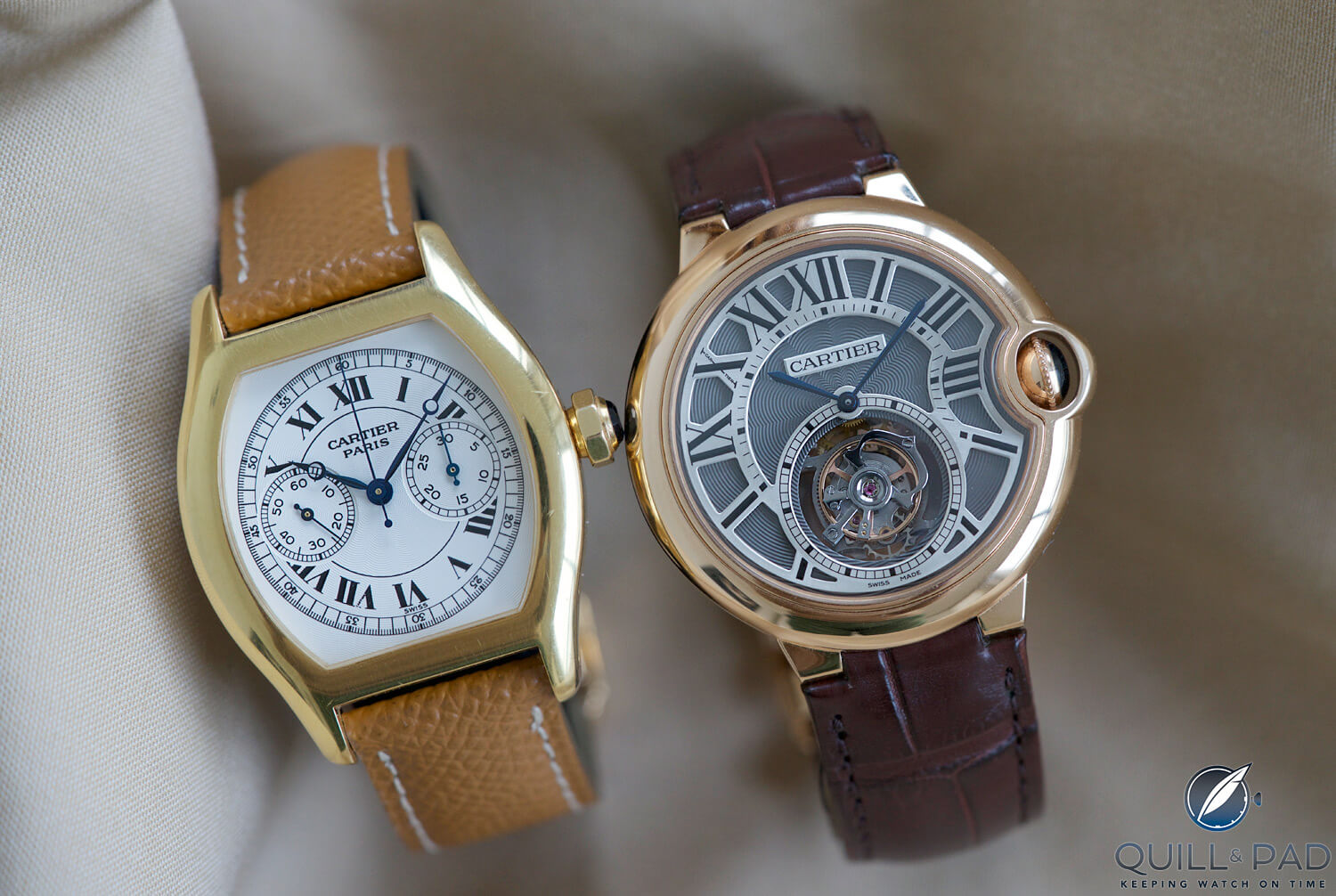
Cartier Tortue (left) and Ballon Bleu Tourbillon (photo courtesy George Gramer)
The dial features the typical layered design that Cartier has favored since 2008 for its high-complication models. This construction lends great depth to the dial and also makes it richer in appearance than a dial with only a stamped guilloche pattern.
In fact, this 39 mm version looks almost identical to the previous 47 mm model, but the smaller diameter is so much better proportioned in every way.
Caliber 9452 MC is also the first Cartier movement awarded the Geneva Seal. This hallmark was made possible by a new Cartier workshop within the Roger Dubuis factory established in that year; Cartier’s parent company Richemont had just acquired Roger Dubuis. The Seal of Geneva guarantees not only that the movement has been manufactured in the canton of Geneva, but that it also has exquisite finish complying with the strict regulations of the certification.
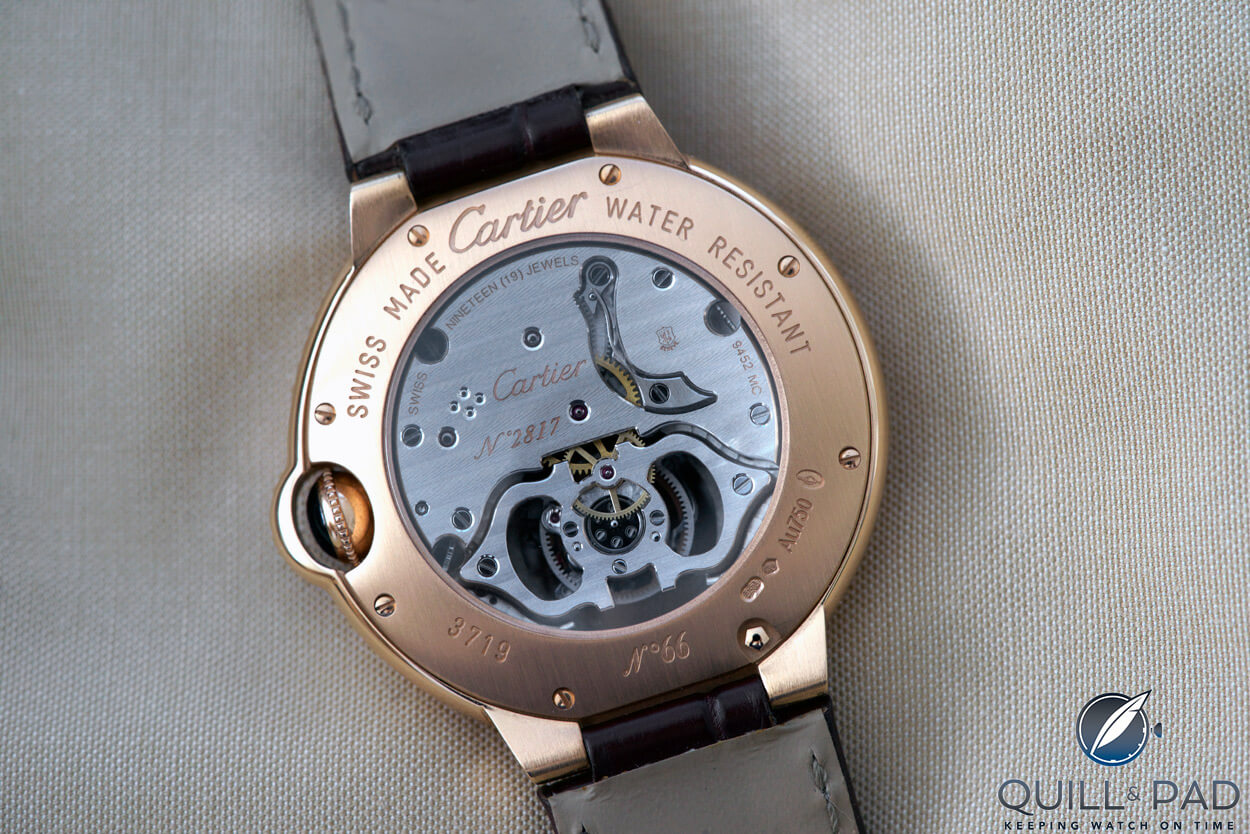
Back of the Cartier Ballon Bleu Tourbillon (photo courtesy George Gramer)
The stringent Geneva Seal requirements demand greater skill in manufacture and finishing, ensuring that it is a certification of quality as well as a statement of provenance. It also proves that Cartier produces mechanical movements that comply with one of the greatest watchmaking traditions, making the brand capable of meeting the very high requirements set for finish and functionality.
The manual-wind caliber with a power reserve of 50 hours contains 142 components, 19 of which are jewels. It is regulated by the flying tourbillon with its smart-looking C-shaped carriage that also indicates seconds.
Each component of the individually numbered mechanical movement has been finished with attention to detail such as chamfered bridges and polished screw heads to meet the standards of the Geneva Seal certification.
Like many of the high-end Cartier watches, the Ballon Bleu Flying Tourbillon comes with a folding buckle in 18-karat pink gold adjustable on two sides with a dark brown alligator skin strap.
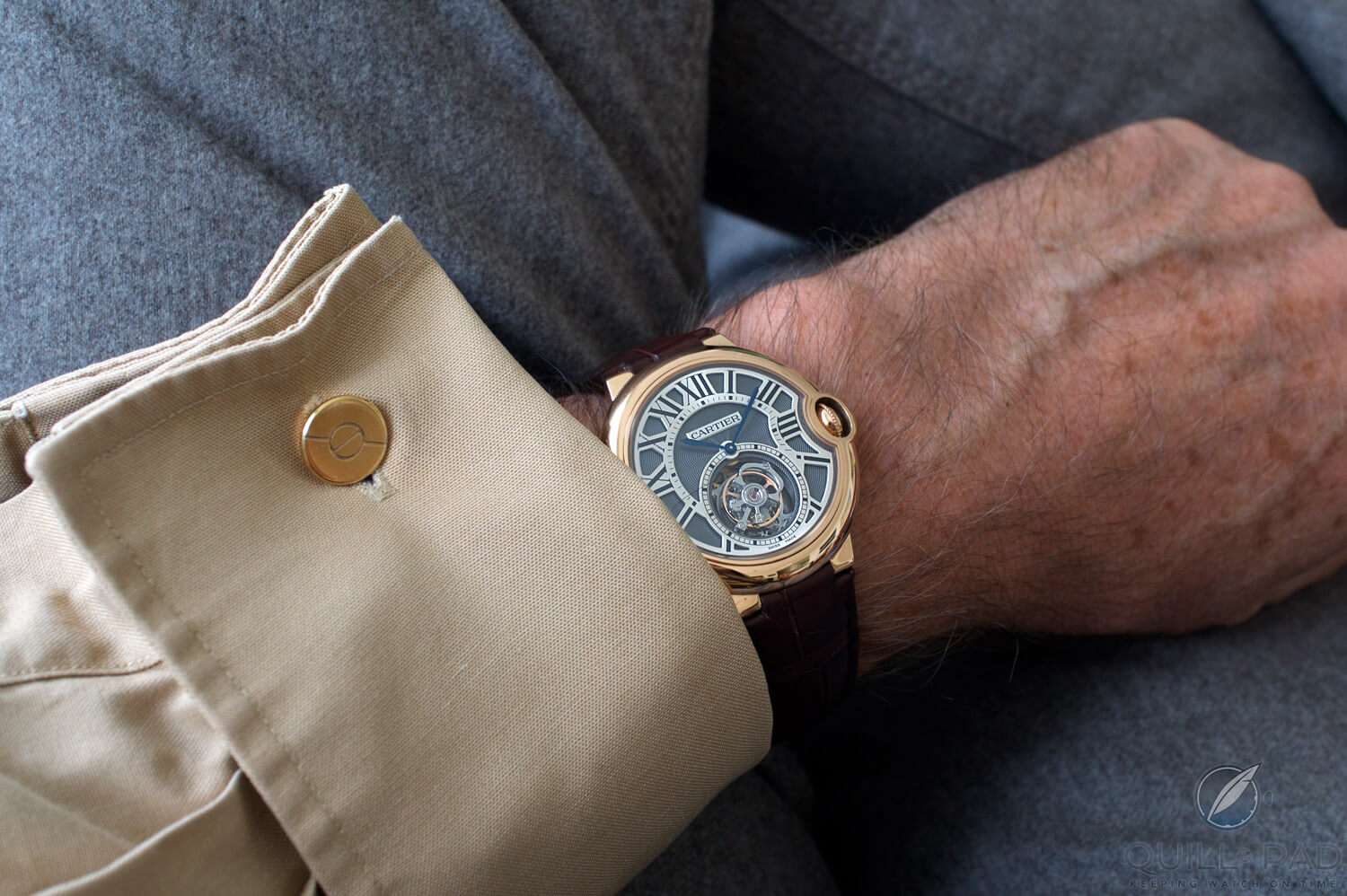
Cartier Ballon Bleu Tourbillon on the wrist (photo courtesy George Gramer)
But unlike many tourbillon watches that come in fairly straightforward round cases, the Ballon Blue Flying Tourbillon de Cartier looks a different, typical where “La Maison” combines high-end watchmaking with a more daring and very comfortable case design.
Quick Facts Ballon Bleu Flying Tourbillon
Case: 39 x 11.4 mm, pink gold, sapphire cabochon on crown
Movement: manually wound Caliber 9452 MC with one-minute flying tourbillon, stamped with Seal of Geneva, power reserve 50 hours
Functions: hours, minutes
Produced: 2014 – 2017
Original price: €94,000 incl. VAT / $99,500





















































Quite frankly, some brands and models are great when making huge watches. I mean it. For example, Breitling is not exactly Breitling if the majority of watches they made were not 43 mm and higher. However, Cartier is not Breitling and, to me, Cartier should do what it does best and that is classical Parisian elegance. Sure, they can innovate a little with materials or design concepts but it should always be with respect to that classical Parisian elegance, meaning smaller watches and perfect proportions. In fact, the Drive’s size and its AP-like crown is very near that line where it doesn’t look good anymore. However, I can allow that but, 47 mm for a tourbillon from Cartier, I think that they could do better than that and hey, it seems they did. Interesting read and I hope I didn’t write too much and sound as though I am pointlessly rambling,
I understand what you’re saying and from what I understood during the various conversations at the last SIHH, I think Cartier will head into the direction you sketch here. More elegant and more what it used to be. Let’s see what the SIHH 2018 will bring us.